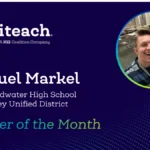For a majority of states where iteach operates, candidates are required to complete a two-semester Field Experience. During your Field Experience, you are the Teacher of Record on some type of Intern Certificate (the terms can differ based on the state). During this time, you still receive all the benefits of being a full-time teacher, like salary pay and health benefits. During your Field Experience, you will be assigned a supervisor who will observe your classroom three times during your first semester and two times during your second semester.
You must be aware that you are required to find your own Field Experience. iteach can point you in the right direction by sharing job fairs and information on districts hiring, but it is your responsibility to connect with the schools, interview, and get hired. Yes, I know this can sound a bit daunting. You may wonder how I can get hired for a job without previous teaching experience! I thought the same thing at first. Then, I paused and thought about all the transferable skills I have acquired from my work, and this moment to reflect helped me gain the confidence that I would find the right place for my Field Experience.
When trying to find and secure your Field Experience, it is crucial to find observation locations, craft your perfect teacher resume with relevant experience, connect with teachers and campus administration, remain persistent during the application process, determine your references, and show that passion for teaching to secure your Field Experience. Follow along to see how I found a Field Experience that aligned with my hopes for my first year of teaching.
Finding Observation Locations
Building connections and networks with my local districts started by finding my observation sites. In Texas, iteach requires candidates to complete at least 30 hours of observations before securing your Field Experience. I recommend setting up school observations even if they are not required in your state; it is a great way to observe some excellent teachers and get to know the school culture.
When starting my research for observations, I looked at the iteach website to find Job Fairs near me. Unfortunately, there were not any in any area at the time. Many stories I had read when deciding to start my alternative teacher certification process noted that people found their Field Experience by being referred by a friend who taught at the school. Although I have friends around the country who are teachers, none of them live in the city where I currently reside and where I wanted to find my Field Experience.
I decided to contact my network to see what they would recommend. I asked a friend who works as an Instructional Coach in another city, and she suggested starting with some online research to determine schools in your area where you would be interested in observing. So similar to how many things begin, I started with a Google search, ‘high schools near me.’ Trusted Google came up with multiple schools in my area, so I looked at school sizes, demographics, campus resources, and so on to find schools that drew my attention. I created a list and started reaching out via email to the Principals I found listed on the school’s website.
Then, it was radio silence. I started to panic, thinking that without connections, it would be impossible even to set foot in a school to observe. I started my outreach in the Spring, only a few weeks before most schools in my area got out for Summer. I reached out again to my friend to see if she had any advice, and she noted that the few weeks before school gets out could be very difficult for administrators, and they are more focused on prom, graduation, and closing out the year strong. She shared that it would be in my best interest to reach out before school starts in the Fall.
The Fall felt so far away, but the reality is that when each semester starts, you may have a window for the best time to hear back from administrators. However, my personal experience does not mean it isn’t possible to hear back from the administration for observations in the last few weeks of the school year. Many schools can be actively searching for teachers at this time, so it is still worth it to make the outreach at any time.
Around mid-August/ early September, I started my outreach again. One local district admin forwarded me to their HR department and provided me with an application for an observation. Another district connected me to the English department head to coordinate a time. It was a relief to hear back and know I would be able to take the next step in my teaching journey. Sometimes, the best things just take a bit of patience.
Once I communicated with the appropriate parties, I began my observations in October. Observations were an incredible opportunity to understand the school culture and students and start to connect with on-campus faculty.
Ways to Make Connections During School Observations
It could be easy to go into your observations and follow the set schedule. You could go class to class and genuinely just observe. Yes, you would still learn so much about implementing a strong lesson plan and seeing how the students respond, but you must remember that observing is not your only task. You are gaining experience but also looking for a job placement. Observations are an excellent resource for building connections and finding out who to connect with to discuss your Field Experience.
I followed the former on my first day or two of observations. I would just go from class to class and say my pleasantries to the teachers I observed, then move on to the next. After reflecting upon my days and realizing that I was enjoying my time at specific schools, I knew I needed to put myself out there and ask some questions. The result was very telling. Each teacher that I would talk to was honest and as helpful as possible. I had a set of a few questions that I started to ask.
- What is the school culture like?
- Do you feel supported by your department and administration?
- How long have you been teaching here?
The answers to these questions will tell you everything you need to know. In addition, when you are setting up your observations, ask your contact if you can observe the department head. The department head should be aware if they have any vacancies and will direct you with where to apply and who to connect with after you apply. In my case, the department head also gave me some great advice.
The principal at a school I observed was known to engage with the students and staff during lunch daily, so the department head recommended that I find her in the cafeteria and introduce myself. She said this would go a long way and help me present myself as more than just a name via email or over an application. I was, of course, nervous to put myself out there this way, but I had already gone through the process of putting myself out there by making this huge career change, so what did I have to lose?
I walked up confidently, introduced myself, and shook her hand. I told her I was observing at the school as part of my alternative teacher certification program and would love to apply for the upcoming semester. She was immediately impressed, and she gave me her card and told me to send over my resume since they did have an opening for the upcoming semester in my content area. She told me that she prefers to hire teachers who have already spent time in the school and understand the dynamics. From there, I sent over my resume, went through the application process, got hired, and am now happily teaching at this school!
Sounds so simple, right!? It can be, but I am jumping several steps. What actually happened after I introduced myself to the principal was a quick panic about how I would update my resume and prepare for the interview and so much more, but stay tuned for part two to learn more about all of that.
What to Keep an Eye Out for During School Observations
Yes, talking to the teachers you observe is going to be a big tell to what the campus is really like and if it is a good fit for you, but to ensure this is where you want to try to get your Field Experience, you need to notice for yourself and trust your gut.
You will likely have a feeling if you feel comfortable in the school, can imagine yourself teaching the student population, and if you connect with the faculty. Take time during your observations to notice. Write a journal about each experience, and put yourself in the shoes of the teachers you observe to see if this is the right fit for you.
Keep an eye out for part two to learn more about crafting your teacher resume with relevant experience, remaining persistent during the application process, determining your references, and showing your passion during the interview process.





